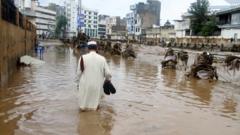The recent monsoon floods and landslides in Pakistan and Pakistan-administered Kashmir have resulted in the tragic loss of at least 307 lives, with the toll expected to rise further. The majority of fatalities have occurred in the mountainous Khyber Pakhtunkhwa province, where disaster authorities report significant damage alongside the loss of human life. At least 74 homes have been destroyed, and a rescue helicopter crashed during operations, claiming the lives of all five crew members.
In Pakistan-administered Kashmir, at least nine fatalities have been reported, while five additional deaths were recorded in the northern Gilgit-Baltistan region. The government’s meteorological services forecast heavy rainfall to persist until 21 August across the north-west of the country, prompting authorities to declare several areas disaster zones.
Amidst the disaster, survivors have shared harrowing experiences. A witness from Buner described the floods as an apocalyptic event, stating, "I heard a loud noise as if the mountain was sliding. I rushed outside and saw the entire area shaking, like it was the end of the world." This perspective highlights the frightening intensity experienced by residents during the calamity.
Khyber Pakhtunkhwa's chief minister, Ali Amin Gadapur, confirmed that the M-17 helicopter crashed due to inclement weather while en route to Bajaur, a border region with Afghanistan. Images captured in Bajaur show a crowd gathering around excavators as rescue efforts unfold in mud-laden terrain, while nearby, communities engage in mourning rituals over the loss of loved ones.
In parallel, the Indian-administered territory of Kashmir reported its own tragedies, including the recovery of at least 60 bodies from a village inundated by the floods. Monsoon season typically results in substantial rainfall across South Asia, with the current year's toll rising to approximately 650 deaths.
Areas like Punjab, where nearly half of Pakistan's 255 million inhabitants reside, recorded rainfall increases of 73% in July compared to the previous year, leading to enhanced devastation. Experts in climate science attribute the intensification of monsoon events to climate change, emphasizing that the fast-retreating glaciers in Northern Pakistan are contributing to increased vulnerability to landslides and floods.
While investigations are ongoing to determine the precise causes of the recent natural disasters, glaciologists note that ice melt is likely a significant factor. The recurrent and increasingly severe monsoon rains destabilize the region's geological structure, heightening the risks faced by the communities living in these areas.




















